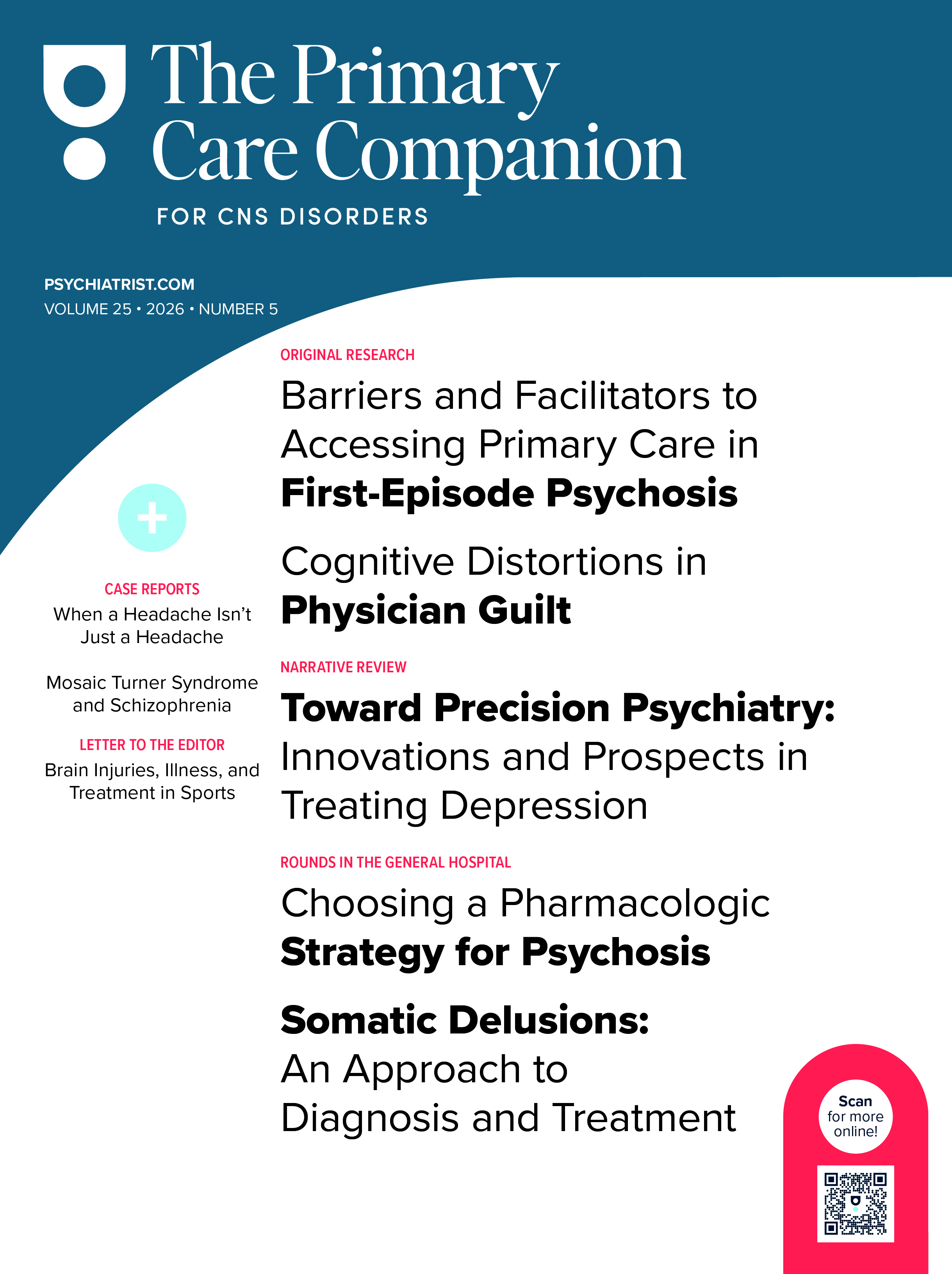Neuroleptic malignant syndrome (NMS) is a neurologic emergency associated with neuroleptic agents and characterized by a syndrome of hyperthermia, rigidity, altered mental status, and autonomic instability, with or without an elevation of creatinine phosphokinase (CPK). Atypical NMS is a diagnosis made when NMS is suspected but not all cardinal signs are present. The mechanism of NMS is excessive dopamine blockade, especially when using agents with an affinity for the D2 pathway.1 Risk factors include antidopaminergic agent use, rapid dose escalation, withdrawal of prodopaminergic agents, increasing age, and increasing medical comorbidities.1 Early recognition of atypical NMS is vital, as the incidence is around 0.02%–0.03% with a mortality rate of 5.6%.1 This report describes atypical NMS in an elevated-risk patient after sudden cessation of varenicline.
Case Report
Mr S, a 51-year-old man with past psychiatric history of schizoaffective disorder, bipolar type, and tobacco use disorder (2.5–3 packs per day), presented to the emergency department (ED) with fever, tremors, slurred speech, and confusion. His stable home medications included 2 antipsychotics, lurasidone 60 mg, and olanzapine 20 mg, in addition to hydroxyzine, lamotrigine, and duloxetine. Two months prior to arrival in the ED, he was initiated on varenicline for smoking cessation, and 1 month prior, the dose was increased. Following the dose increase, he experienced irritability and insomnia but did not stop smoking abruptly until 2 weeks before arrival. Due to persistent, worsening irritability, he stopped the varenicline abruptly 1 week before presenting to the ED and soon thereafter began to experience fever, rigidity, tremors, slurred speech, polydipsia, and altered mental status, which prompted presentation to the ED.
On examination, Mr S was diaphoretic, with dry mucus membranes and bilateral resting tremor in upper extremities, which worsened with action, with moderate rigidity throughout. His temperature was elevated at 103.2 F°, with a blood pressure of 160/90 mm Hg, heart rate of 104 bpm, and respiratory rate of 26 breaths/minute with no supplemental oxygen requirement. Laboratory values were notable for leukocytosis of 13.1 × 109 cells/L, hyponatremia of 121 mEq/L, and compensated metabolic acidosis. Urine drug screen, CPK, and lactate values were negative. Brain magnetic resonance imaging showed no acute changes. His fever was unresponsive to treatment, so cooling measures were initiated in the ED, and he was transferred to the medical floor for further management. The primary team held all psychotropic medications upon admission, and the psychiatry department was consulted due to concern for atypical NMS.
Upon evaluation, the psychiatry team recommended to not restart olanzapine and lurasidone, and to start lorazepam 1 mg up to 3 times/d as needed for rigidity and agitation, for inpatient use only. This resulted in an abrupt stop of home antipsychotics. In addition, it was recommended to restart home lamotrigine, duloxetine, and hydroxyzine. The patient’s confusion, rigidity, and hyperthermia improved within 24 hours after complete cessation of antipsychotics and completely resolved by hospital day 4. Hyponatremia was attributed to a combination of syndrome of inappropriate antidiuretic hormone secretion (SIADH) and psychogenic polydipsia, which improved to a sodium level of 131 mEq/L with fluid restriction. Subsequently, psychiatry recommended a gradual taper off duloxetine, which included 5 days of a halved dose and cessation of the medication on day 6, with outpatient psychiatry follow-up appointment.
Discussion
This case highlights several pharmacokinetic and pharmacodynamic interactions that are noteworthy. One in 3 patients with mental illness smoke cigarettes, and combustion of organic matter creates polycyclic aromatic hydrocarbons, which induce cytochrome P450 isoenzyme 1A2, which is particularly relevant to medications like olanzapine.2,3 Varenicline is an agent with US Food and Drug Administration approval for smoking cessation that acts as a nicotinic acetylcholine receptor partial agonist, which causes an increase in dopamine signaling in the mesolimbic tract and thereby reduces nicotine cravings.4 In this case, the patient was started on varenicline, which was successful in smoking cessation. This, in turn, would have significantly increased the plasma levels of his olanzapine as the inhalation of combustion products of a smoked cigarette decreased and would have also increased his risk of psychogenic polydipsia. Next, while he continued taking varenicline, he would have experienced a net increase in dopaminergic activity that would have suddenly decreased when the varenicline was discontinued. To add to the complexity of this case, the clinical picture was complicated by SIADH and symptoms of polydipsia, agitation, and dizziness, in which various psychotropic medications such as antipsychotics and serotonin-norepinephrine reuptake inhibitors are risk factors.5
It is imperative that the treating provider be astute to symptoms of atypical NMS in elevated-risk patients after abrupt cessation of varenicline. This is the first report, to our knowledge, of varenicline withdrawal being implicated in the development of atypical NMS.
Article Information
Published Online: November 27, 2025. https://doi.org/10.4088/PCC.25cr04004
© 2025 Physicians Postgraduate Press, Inc.
Prim Care Companion CNS Disord 2025;27(6):25cr04004
Submitted: May 16, 2025; accepted August 13, 2025.
To Cite: Nava Frenier MA, Lydiatt MF. From varenicline to neuroleptic malignant syndrome: the complex effects of smoking cessation on dopamine regulation. Prim Care Companion CNS Disord 2025;27(6):25cr04004.
Author Affiliations: Department of Psychiatry, University of Nebraska Medical Center, Omaha, Nebraska (Nava Frenier, Lydiatt).
Corresponding Author: Monica A. Nava Frenier, 985575 Nebraska Medical Center, Omaha, Nebraska 68198-5575 ([email protected]).
Relevant Financial Relationships: None.
Funding/Support: None.
Patient Consent: Verbal and written consent was received from the patient to publish the case report, and information has been de-identified to protect patient anonymity.
References (5)

- Pileggi DJ, Cook AM. Neuroleptic malignant syndrome. Ann Pharmacother. 2016;50(11):973–981. PubMed CrossRef
- Mendelsohn CP, Kirby DP, Castle DJ. Smoking and mental illness. An update for psychiatrists. Australas Psychiatry. 2015;23(1):37–43. PubMed CrossRef
- Deng M, Yang Z, Ni Y, et al. Effects of varenicline on the serum levels of olanzapine in male patients with schizophrenia: a randomized controlled trial. Front Psychiatry. 2023;14:1142419. PubMed CrossRef
- Nides M, Oncken C, Gonzales D, et al. Smoking cessation with varenicline, a selective alpha4beta2 nicotinic receptor partial agonist: results from a 7-week, randomized, placebo- and bupropion-controlled trial with 1-year follow-up. Arch Intern Med. 2006;166(15):1561–1568. PubMed CrossRef
- Bassi V, Fattoruso O, Santinelli C. A rare iatrogenic association of syndrome of inappropriate secretion of antidiuretic hormone, neuroleptic malignant syndrome and rhabdomyolysis. Oxf Med Case Rep. 2019;2019(3):omz010. PubMed CrossRef
Please sign in or purchase this PDF for $40.





